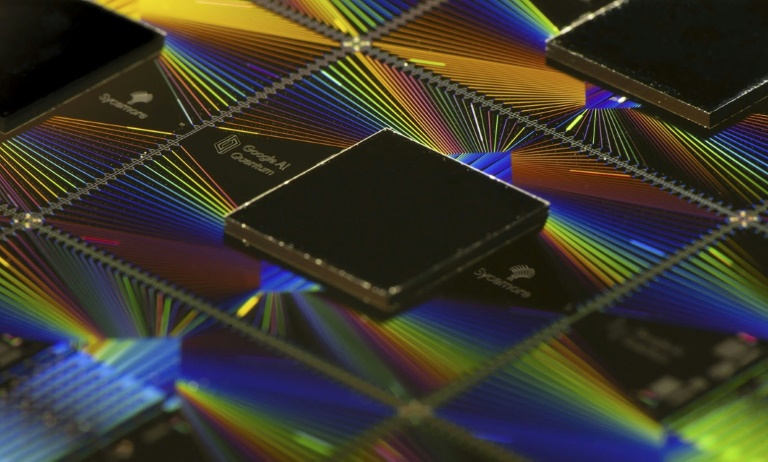Science
Quantum Brilliance Unveils Room-Temperature Quantum Computer at ORNL

Quantum Brilliance has introduced its innovative quantum computer technology at the Oak Ridge National Laboratory (ORNL), marking a significant advancement in the integration of quantum systems with classical high-performance computing. The installation of the Quantum Brilliance system in ORNL’s Advanced Computing Ecosystem testbed establishes the facility’s very first on-site quantum computer cluster. This milestone opens new avenues for researchers to explore the potential of quantum technology alongside traditional computing methods.
Details of the Quantum Development Kit
The quantum computer deployed at Oak Ridge is known as the Quantum Development Kit (QDK). According to Andreas Sawadsky, Technology & Innovation Manager at Quantum Brilliance, this hybrid system features a quantum processing unit (QPU) integrated with both GPU and CPU components. This configuration allows the QDK to support parallel and hybrid quantum-classical workflows. Each QPU in the system contains two qubits, marking the first instance of a multiple-hybrid system operating in a cluster setting. Sawadsky noted that this development represents a groundbreaking achievement as it integrates parallelized QPUs within a high-performance computing environment.
Previous Deployments and Future Implications
While this is Quantum Brilliance’s inaugural deployment in the United States, it follows a successful installation at the Pawsey Supercomputing Centre in Perth, Australia, in 2022. That system was the first to integrate a QPU into an HPC environment on-premises. An upgraded model was subsequently delivered to the Fraunhofer IAF in Freiburg, Germany. The recent installation at ORNL signifies a strategic step forward, placing Quantum Brilliance’s technology in one of the world’s foremost research institutions focused on hybrid computing.
The underlying technology of Quantum Brilliance’s quantum computers leans heavily on solid-state spin-based quantum systems. The QPUs utilize nitrogen-vacancy (NV) centres embedded in diamonds. These atomic-scale defects, where a nitrogen atom is adjacent to a vacant lattice site in the diamond, serve as qubits. The manipulation of these qubits is achieved through laser light and microwave pulses, enabling the execution of complex quantum algorithms.
One of the technology’s most notable advantages is its ability to operate at room temperature, which contrasts sharply with many existing quantum platforms that require extreme cooling to maintain quantum coherence. Sawadsky explained that traditional qubit technologies are often susceptible to decoherence due to heat and electromagnetic noise, necessitating cryogenic environments. In Quantum Brilliance’s case, the diamond host material provides an inherently stable environment.
Advantages of Diamond-Based QPUs
Diamonds are exceptionally robust, and at room temperature, they do not produce sufficient thermal energy to disrupt qubit coherence. Moreover, the purity of diamond materials minimizes internal sources of electromagnetic noise. This stability allows NV centres to function as if they were in millikelvin conditions found in other materials, enabling the development of a QPU solution that operates efficiently without the complexities and costs associated with cryogenic systems. Consequently, this technology is ideal for applications in data centres, satellites, and edge devices.
Quantum Brilliance distinguishes itself by focusing on the practical utility of quantum computing within HPC environments. Rather than merely aiming to demonstrate quantum advantage in isolation, the company seeks to develop QPUs capable of outperforming classical systems of similar size and power. The goal is to create a QPU compact enough to fit in a lunchbox, promoting portability and ease of integration into everyday applications.
At ORNL, Quantum Brilliance is investigating the scalability of clusters of QPUs, hypothesizing that a cluster of 100 QPUs could outperform an equivalent cluster of 100 GPUs. This approach aims to maximize the benefits of parallelization and hybridization, which are integral to the design of the ORNL deployment.
Innovative Naming and Global Vision
The installation team at Quantum Brilliance has named the cluster “Quoll,” after an Australian marsupial, reflecting both the company’s roots and the novel architectural approach of the system. The name embodies the vision of a quantum future where multiple QPUs can collaborate seamlessly within HPC systems to enhance quantum acceleration.
With operations extending across Australia and Germany, Quantum Brilliance aims to facilitate the widespread deployment of quantum technology. The company has garnered a diverse range of international partnerships, including collaborations with governments, supercomputing centres, research organizations, and industry leaders across North America, Europe, and the Asia Pacific.
As Quantum Brilliance continues to push the boundaries of quantum computing, the integration of their technology into mainstream applications may soon alter the landscape of high-performance computing. The installation at ORNL is just the latest illustration of how quantum advancements can complement classical computing, paving the way for a new era of computational capability.
-

 Lifestyle2 months ago
Lifestyle2 months agoWinnipeg Celebrates Culinary Creativity During Le Burger Week 2025
-

 Education2 months ago
Education2 months agoBrandon University’s Failed $5 Million Project Sparks Oversight Review
-

 Science3 months ago
Science3 months agoMicrosoft Confirms U.S. Law Overrules Canadian Data Sovereignty
-

 Health3 months ago
Health3 months agoMontreal’s Groupe Marcelle Leads Canadian Cosmetic Industry Growth
-

 Science3 months ago
Science3 months agoTech Innovator Amandipp Singh Transforms Hiring for Disabled
-

 Technology3 months ago
Technology3 months agoDragon Ball: Sparking! Zero Launching on Switch and Switch 2 This November
-

 Education3 months ago
Education3 months agoRed River College Launches New Programs to Address Industry Needs
-

 Technology4 weeks ago
Technology4 weeks agoDiscord Faces Serious Security Breach Affecting Millions
-

 Technology3 months ago
Technology3 months agoGoogle Pixel 10 Pro Fold Specs Unveiled Ahead of Launch
-

 Science3 months ago
Science3 months agoChina’s Wukong Spacesuit Sets New Standard for AI in Space
-

 Business2 months ago
Business2 months agoRocket Lab Reports Strong Q2 2025 Revenue Growth and Future Plans
-

 Education3 months ago
Education3 months agoAlberta Teachers’ Strike: Potential Impacts on Students and Families
-

 Technology3 months ago
Technology3 months agoWorld of Warcraft Players Buzz Over 19-Quest Bee Challenge
-

 Business3 months ago
Business3 months agoNew Estimates Reveal ChatGPT-5 Energy Use Could Soar
-

 Business3 months ago
Business3 months agoDawson City Residents Rally Around Buy Canadian Movement
-

 Technology1 month ago
Technology1 month agoHuawei MatePad 12X Redefines Tablet Experience for Professionals
-

 Technology3 months ago
Technology3 months agoFuture Entertainment Launches DDoD with Gameplay Trailer Showcase
-

 Technology3 months ago
Technology3 months agoInnovative 140W GaN Travel Adapter Combines Power and Convenience
-

 Science3 months ago
Science3 months agoXi Labs Innovates with New AI Operating System Set for 2025 Launch
-

 Business3 months ago
Business3 months agoBNA Brewing to Open New Bowling Alley in Downtown Penticton
-

 Technology3 months ago
Technology3 months agoGlobal Launch of Ragnarok M: Classic Set for September 3, 2025
-

 Technology3 months ago
Technology3 months agoNew IDR01 Smart Ring Offers Advanced Sports Tracking for $169
-

 Education2 months ago
Education2 months agoNew SĆIȺNEW̱ SṮEȽIṮḴEȽ Elementary Opens in Langford for 2025/2026 Year
-

 Technology3 months ago
Technology3 months agoArsanesia Unveils Smith’s Chronicles with Steam Page and Trailer










